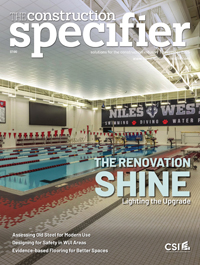Key considerations for designing fenestration systems for success
Safety glass
With some exceptions, safety glazing is required in windows as per the International Building Code (IBC) when all the following glazing conditions are met:
- Area is greater than 0.8 m2 (9 sf).
- Location is less than 457 mm (18 in.) off the floor.
- Location greater than 914 mm (36 in.) off the floor.
- Walking surface is within 914 mm (36 in.) of
the glazing.
In new buildings, especially commercial construction, there is almost always a location where safety glazing is required. Each city and state’s building code will include specific safety glass requirements in detail, typically listed under glass and glazing. There are two types of safety glass to consider: laminated glass with a dedicated interlayer, or fully tempered glass—each with its own advantages and disadvantages.
Laminated glass
Laminated glass is often chosen because should the glass break, the laminate will hold the glass in place and prevent it from falling out of the frame. Ionoplast interlayers in laminated glass are stronger and more rigid than other laminating materials, for example, polyvinyl butyral (PVB) film which is also typically used in common four-side supported vertical fenestrations in commercial construction. For ionoplast interlayers, the assembly may be stiff enough to take loading or remain vertical, such as for glass railings This is why laminated glass is required for the interior lite of skylights that are manufactured without a secondary retention screen. The laminate will prevent broken glass from falling onto occupants below.
Other benefits of laminated glass include improved acoustic performance and filtering ultraviolet (UV) radiation. However, laminated glass is usually more expensive due to the laminating process. This is where fully tempered glass becomes an attractive option for many applications as it meets safety glazing requirements.
Tempered glass
Fully tempered glazing comes with its own challenges, however. Nickel sulfide (NiS) impurities introduced into the glass during its manufacture can result in spontaneous glass fracture if it is fully tempered. NiS has a different high- and low-temperature crystalline structure; with the low-temperature form being less dense yet more stable.
During the rapid cooling process of tempering, the NiS may be locked into its relatively dense and unstable, high-temperature crystalline form. The cumulative effect of normal heating on the NiS “stone” during service (e.g. solar loads, normal diurnal temperature cycles, etc.) eventually causes it to transform into a more stable and less dense low-temperature form. When this phase of transformation takes place, the stone expands.








